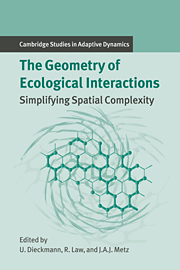Book contents
- Frontmatter
- Contents
- Contributing Authors
- 1 Introduction
- Part A Empirical and Statistical Background: A Plant Ecological Perspective
- Part B When the Mean-field Approximation Breaks Down
- Part C Simplifying Spatial Complexity: Examples
- Part D Simplifying Spatial Complexity: Techniques
- References
- Index
- International Institute for Applied Systems Analysis
1 - Introduction
Published online by Cambridge University Press: 14 January 2010
- Frontmatter
- Contents
- Contributing Authors
- 1 Introduction
- Part A Empirical and Statistical Background: A Plant Ecological Perspective
- Part B When the Mean-field Approximation Breaks Down
- Part C Simplifying Spatial Complexity: Examples
- Part D Simplifying Spatial Complexity: Techniques
- References
- Index
- International Institute for Applied Systems Analysis
Summary
Species form different kinds of patches; these patches form a mosaic and together constitute the community. Recognition of the patch is fundamental to an understanding of structure. Patches are dynamically related to each other. But there are also departures from this inherent tendency to orderliness. At any given time, therefore, structure is the resultant of causes which make for order, and those that tend to upset it. Both sets of causes must be appreciated.
Abbreviated from Watt (1947, p. 2) Pattern and process in the plant communityA sea change has come over theoretical ecology in the past 10 years. The era of the simple general model that tries to capture the elusive essence of an ecological community is rapidly fading from sight. This is the age of the individual-based, spatially explicit, computer-based model (Huston et al 1988; DeAngelis and Gross 1992; Judson 1994).
Why has this transformation taken place? First there is the simple matter of practicality: desktop computing power has reached a level at which it is quite feasible to simulate individuals as they move across a landscape, interact, reproduce, and die. Second is the issue of language: for many ecologists, rules encoded in computer algorithms are much more accessible than the formal mathematical language of dynamical systems. Third is the appreciation that important ecological intricacies, such as the mechanisms by which organisms interact in communities, often cannot be incorporated sufficiently faithfully into simple models. Fourth is an awareness that the simple models traditionally used in ecology have not always proved very successful in accounting for phenomena observed in natural systems.
- Type
- Chapter
- Information
- The Geometry of Ecological InteractionsSimplifying Spatial Complexity, pp. 1 - 6Publisher: Cambridge University PressPrint publication year: 2000
- 12
- Cited by



